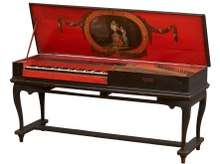Johann Adolph Hass
Johann Adolph Rudolph Hass (baptised 12 March 1713, buried 29 May 1771), usually known as Johann Adolph Hass, was a German maker of clavichords, harpsichords and possibly organs. He was the son of Hieronymus Albrecht Hass, also a maker of keyboard instruments.
Johann Adolph Hass | |
|---|---|
 Clavichord, 1760, Museum für Kunst und Gewerbe Hamburg | |
| Baptised | 12 March 1713 |
| Died | buried 29 May 1771 |
| Other names |
|
| Citizenship | Hamburg |
| Occupation | maker of keyboard instruments |
Life
Hass was born in the Imperial Free City of Hamburg, and was baptised on 12 March 1713. He became a citizen of the city on 28 October 1746, and was admitted to the chamber of commerce in the following year.[1]
There is no mention of either Hass before 1758, when Jakob Adlung mentioned a cembal d'amour made by "Hasse in Hamburg".[1] Both father and son are mentioned in the German translation of Charles Burney's The Present State of Music in Germany, the Netherlands, and United Provinces (1773): "Hasse, father and son, of Hamburg, both dead; their harpsichords and clavichords are much sought after".[2]:238 Ernst Ludwig Gerber said much the same in his Historischbiographisches Lexicon of 1790.[2]:238
Hass died in Hamburg and was buried on 29 May 1771. His business may have been continued by Johann Christoffer Krogmann, a builder of fortepianos who was married to Hass's daughter Margaretha Catharina.[1]
Instruments
Hass's instruments are cleverly designed, strongly built, richly decorated and finely finished.[2]:238
He built large clavichords of the kind that post-Baroque composers such as Carl Philipp Emanuel Bach wrote for, with good tone and volume, and capable of expressive bebung.[1]
Eight Hass harpsichords are known to survive. A massive instrument by Johann Adolph with two manuals and five sets of strings (16', 2 × 8', 4', 2'), with tortoiseshell natural keys and ivory-topped sharps, dates from 1760–1761, and is now in the Yale University Collection of Musical Instruments in New Haven, Connecticut.[3]:312–313 A single-manual instrument from 1764, with two 8' and one 4' sets of strings, is in the Russell Collection in Edinburgh.[3]:313–314
References
- Donald Howard Boalch, Peter Williams, Alexander Pilipczuk ([n.d.]). Hass. Grove Music Online. Oxford Music Online. Oxford: Oxford University Press. Accessed March 2017. (subscription required).
- Hendrik Broekman (2007). Hass. In: Igor Kipnis (editor) (2007). The Harpsichord and Clavichord: An Encyclopedia, volume 2 of Encyclopedia of Keyboard Instruments. Abingdon, Oxfordshire; New York: Routledge. ISBN 9780415937658.
- Edward L. Kottick (2003). A History of the Harpsichord. Bloomington, Indiana: Indiana University Press. ISBN 9780253341662.
Further reading
- Raymond Russell, The Harpsichord and Clavichord (London, 1959, 2/1973)
- Frank Hubbard, Three Centuries of Harpsichord Making (Cambridge, MA, 1965, 2/1967)